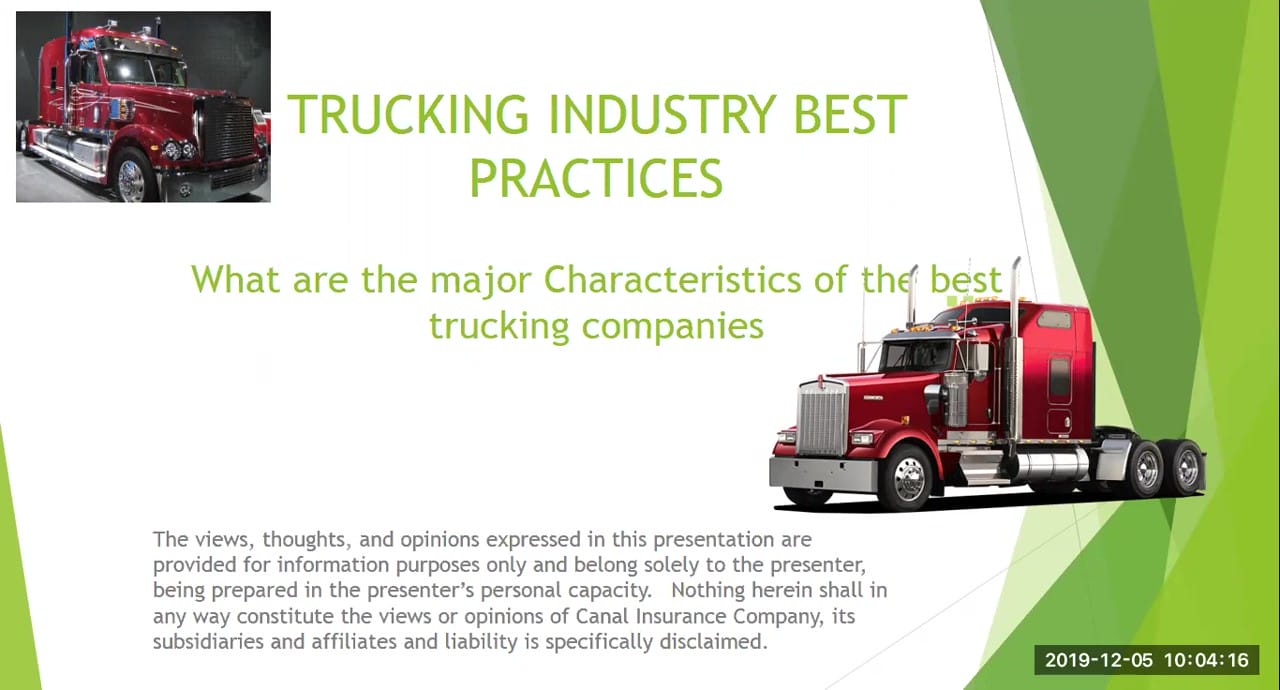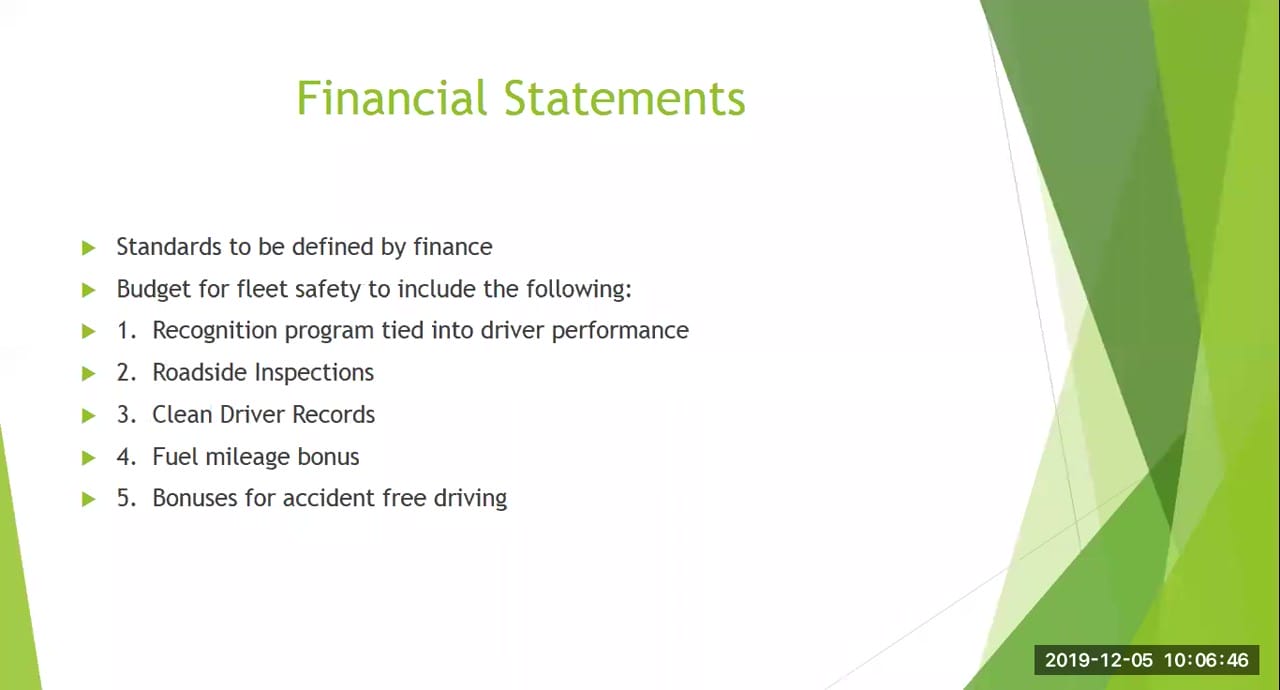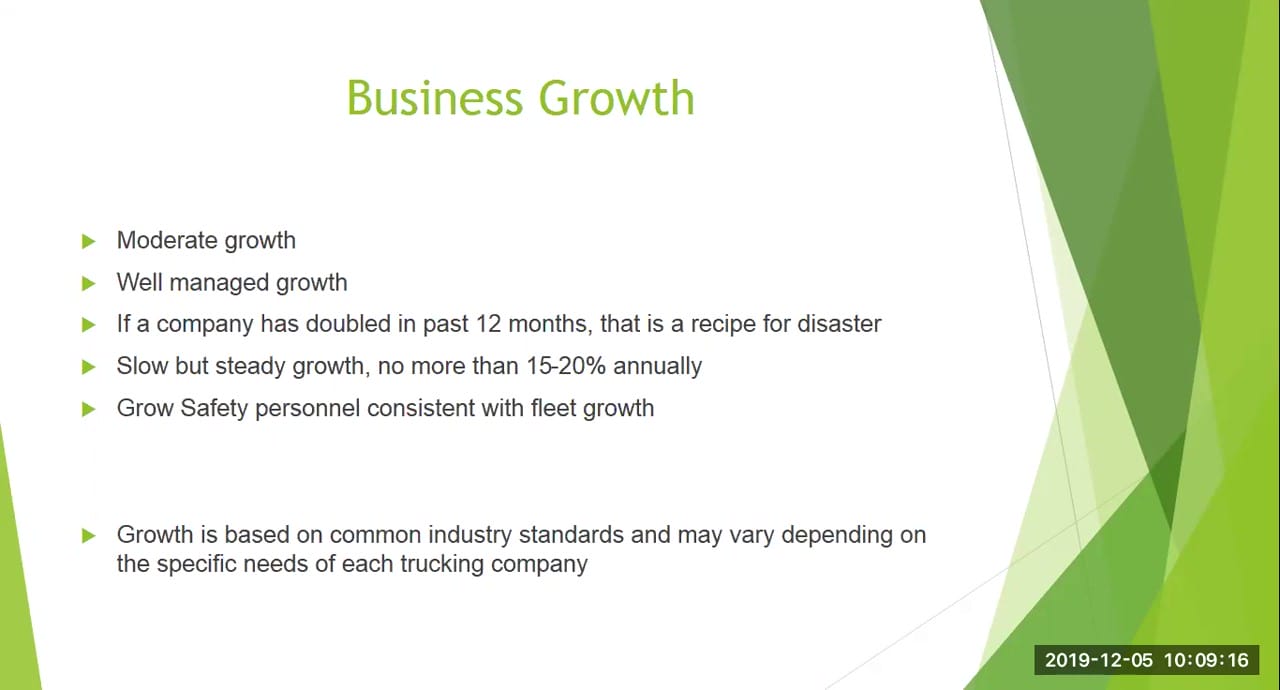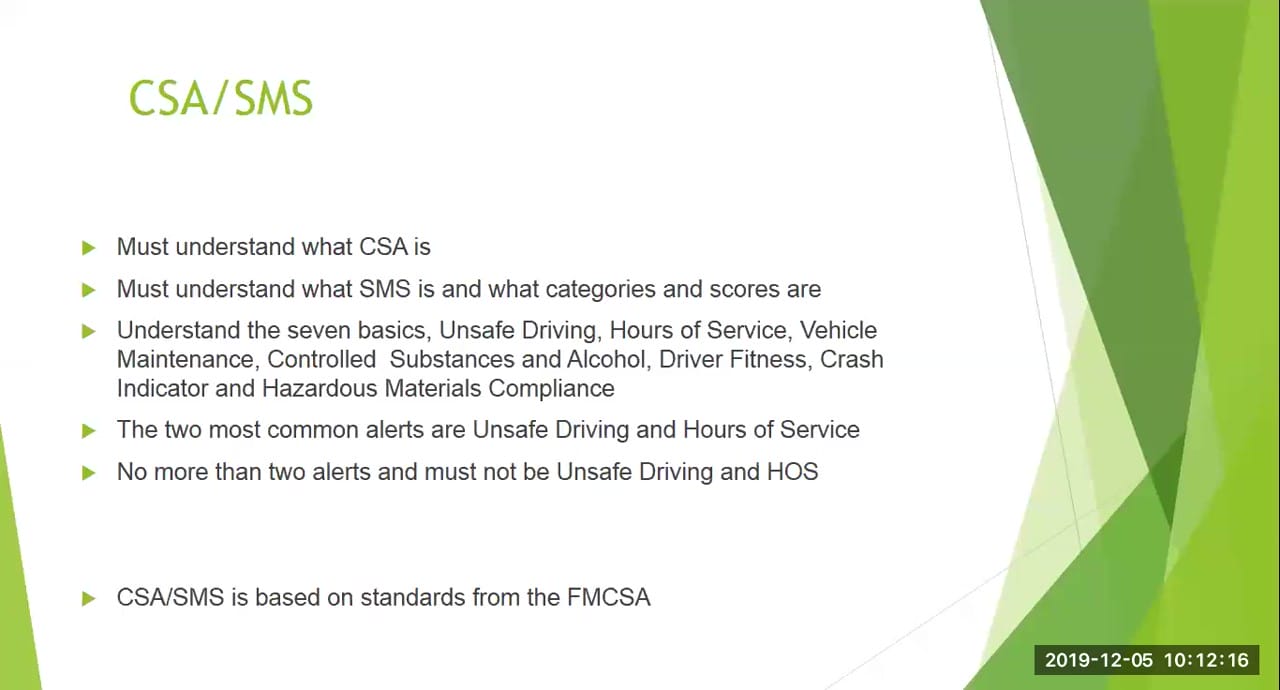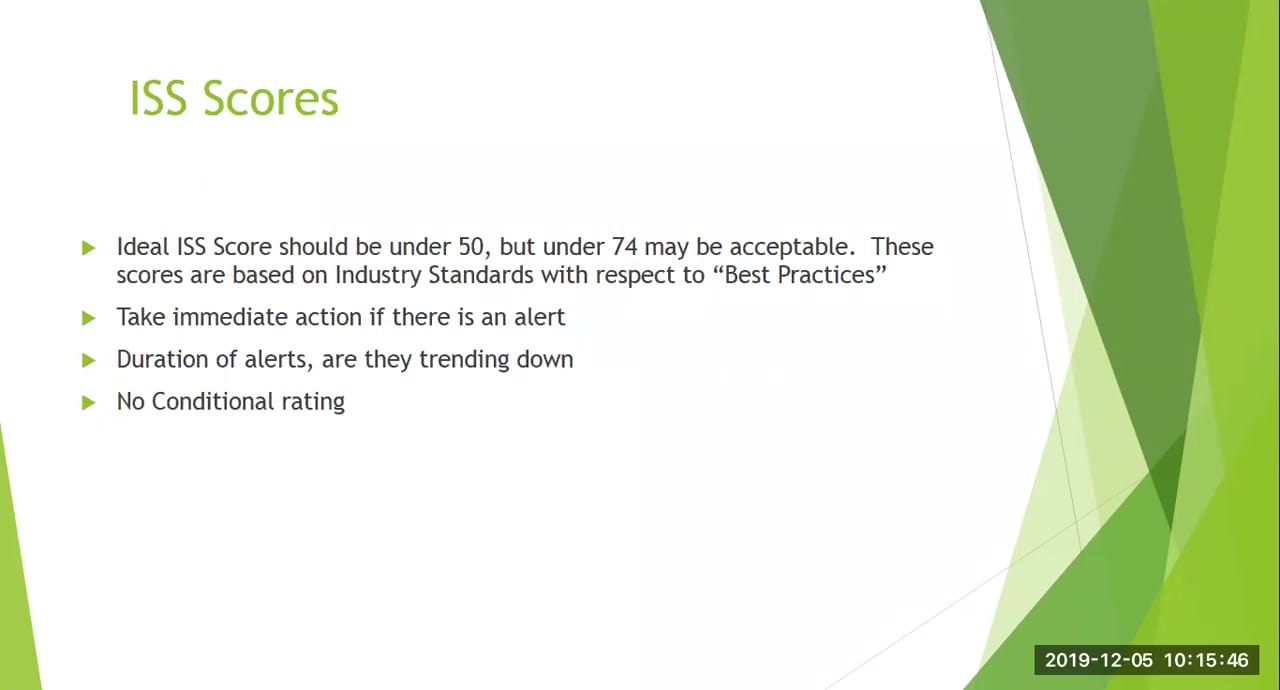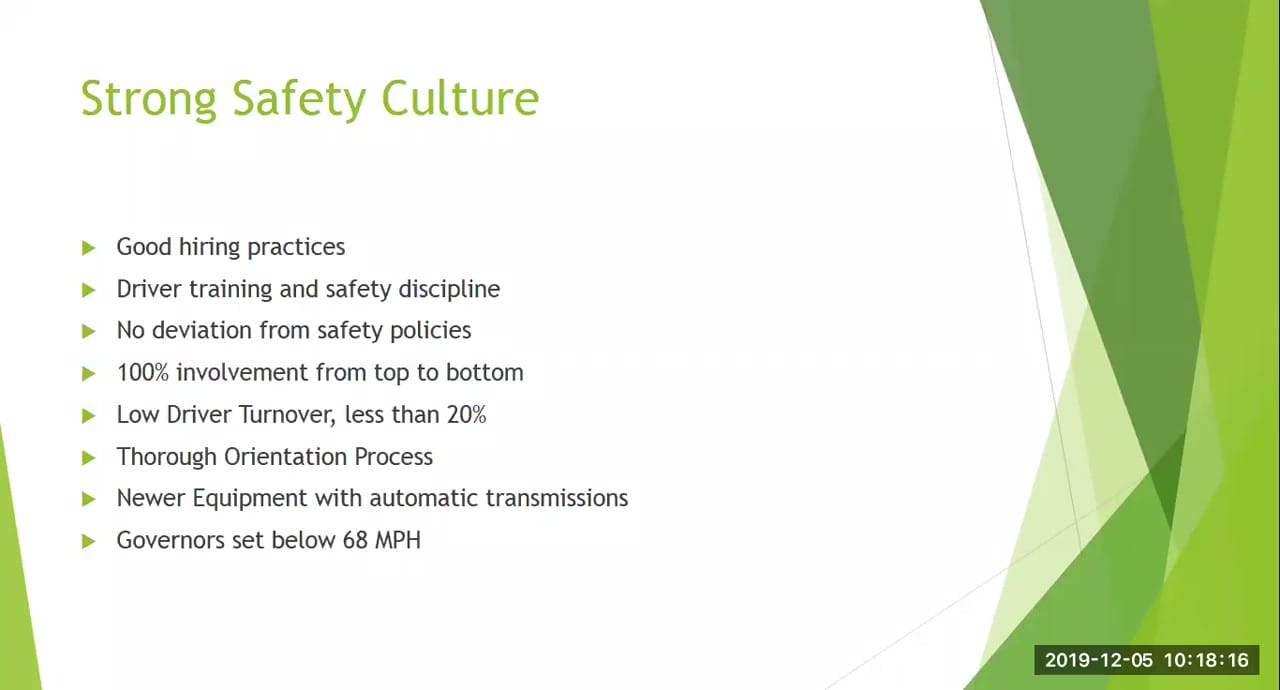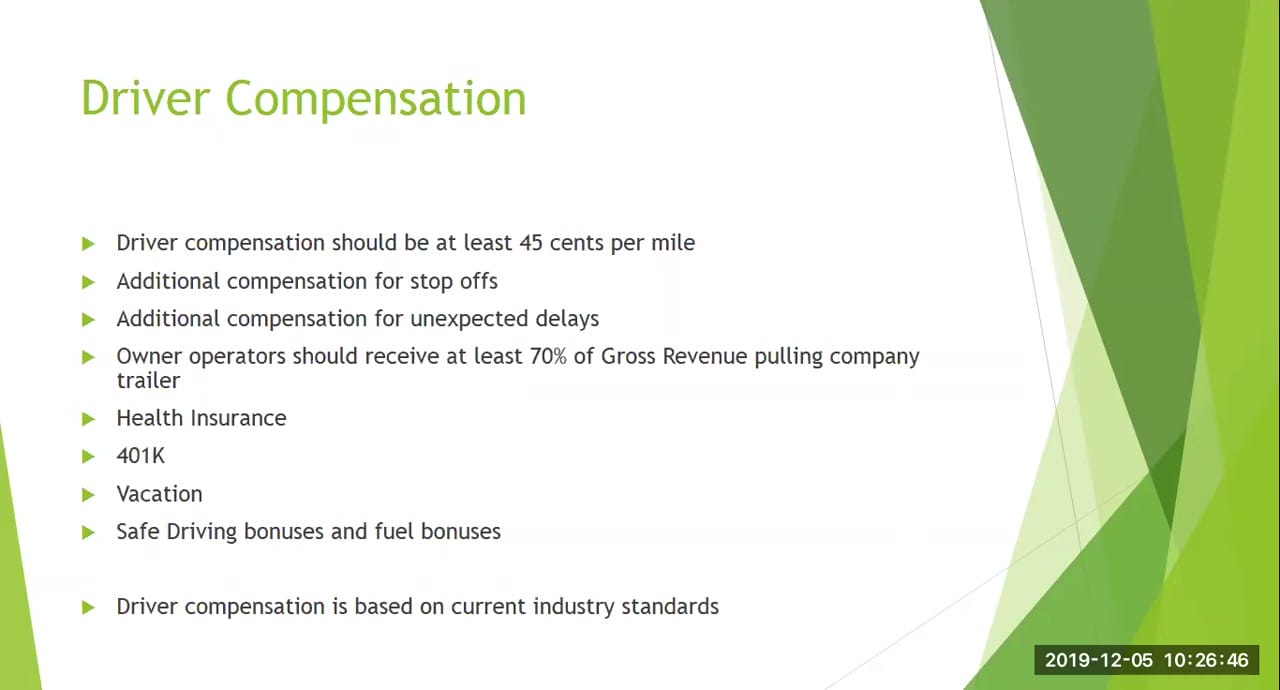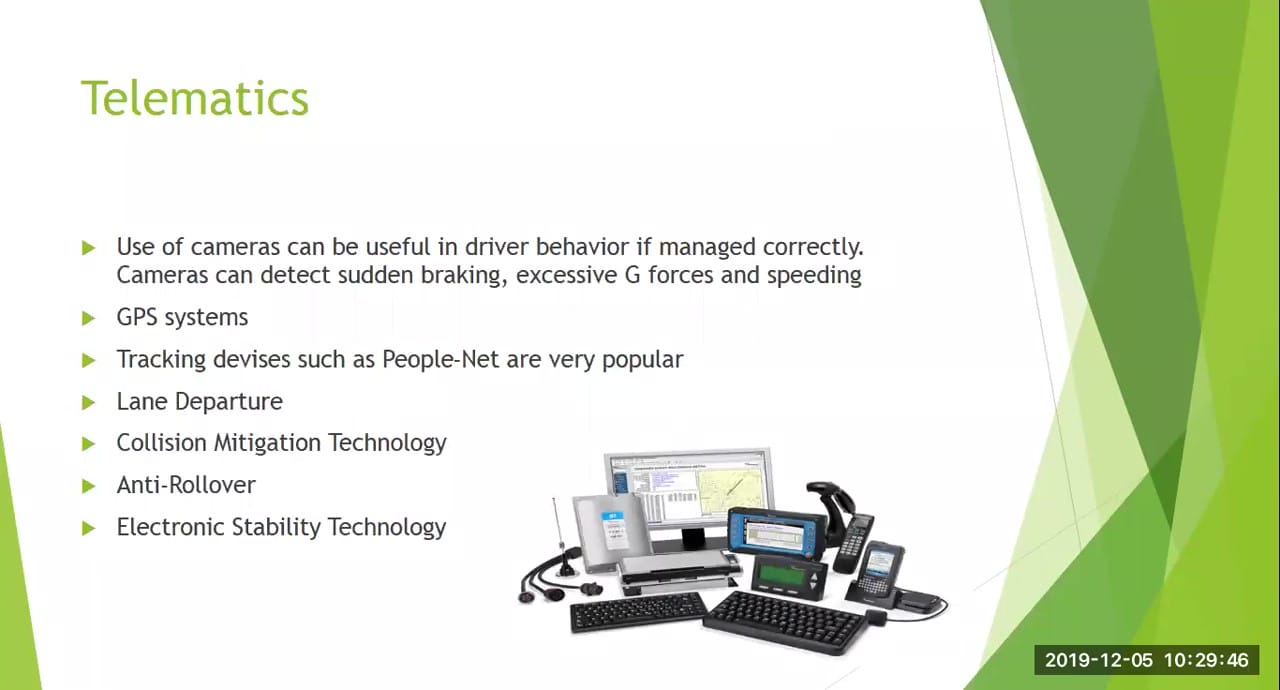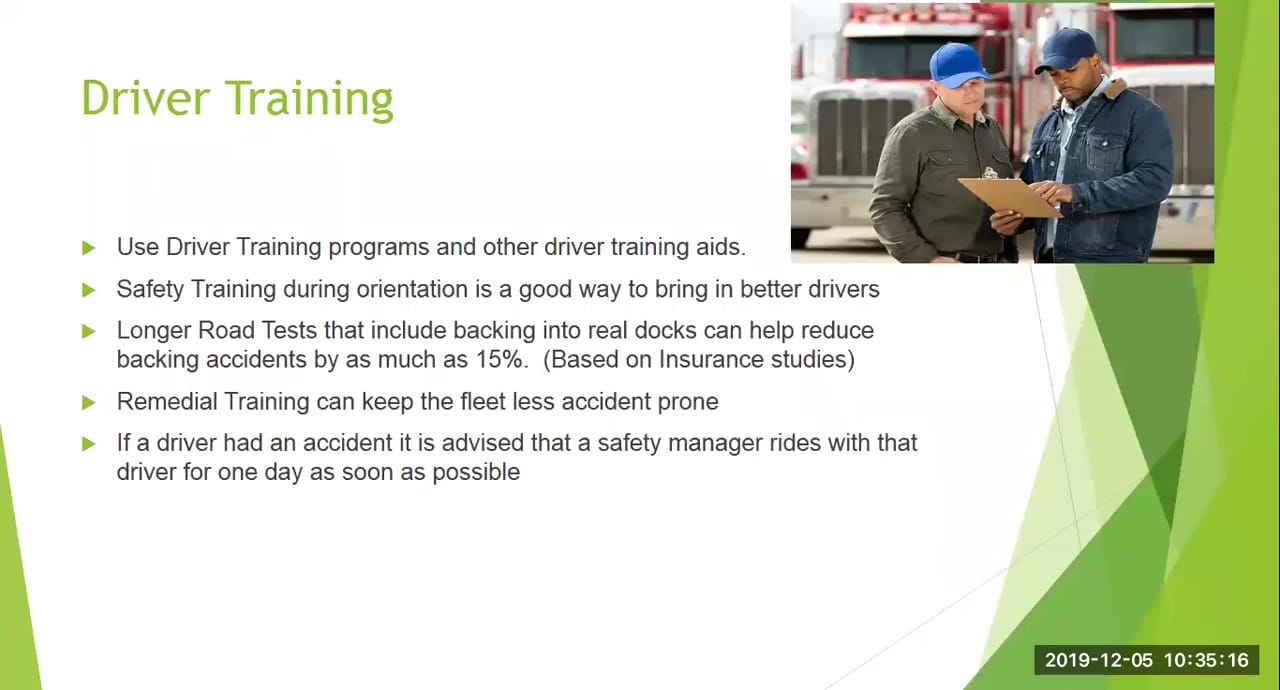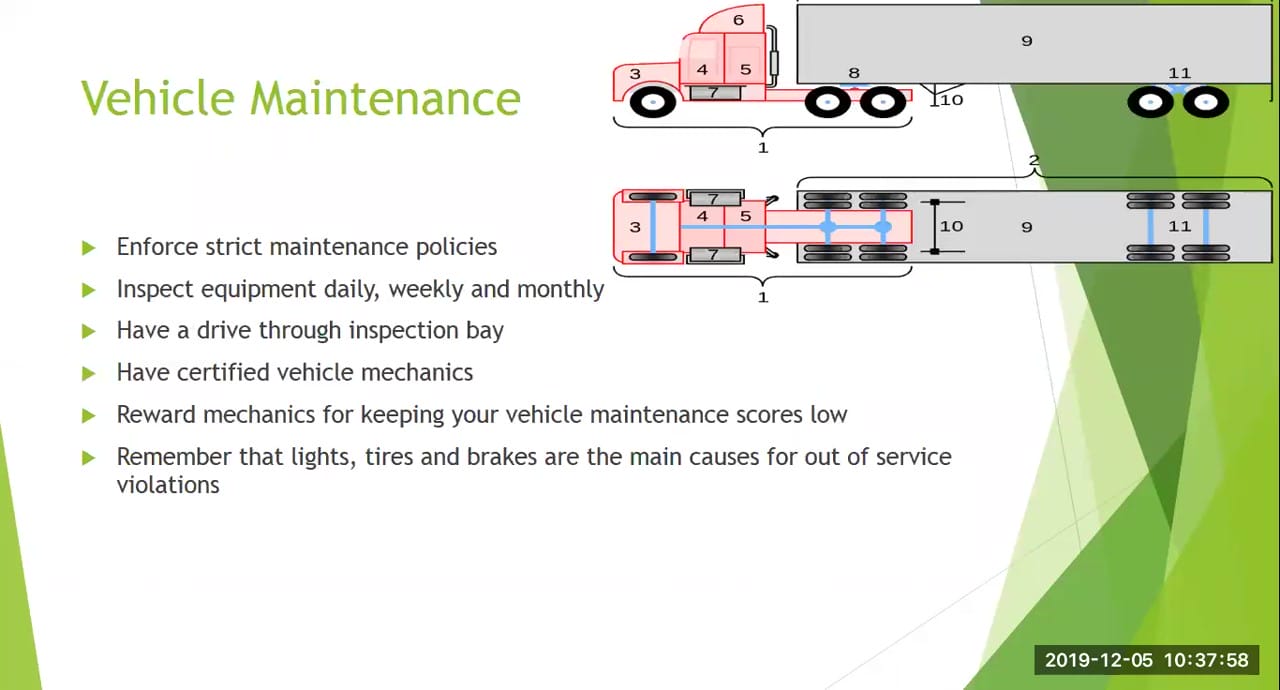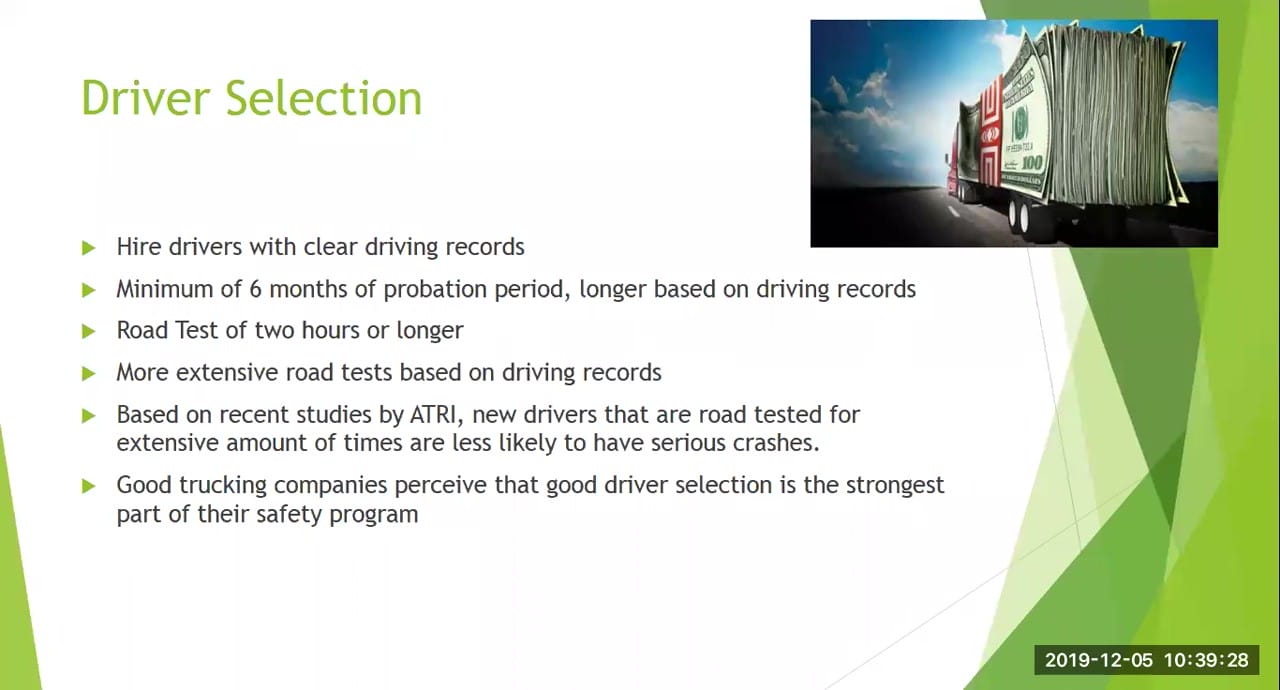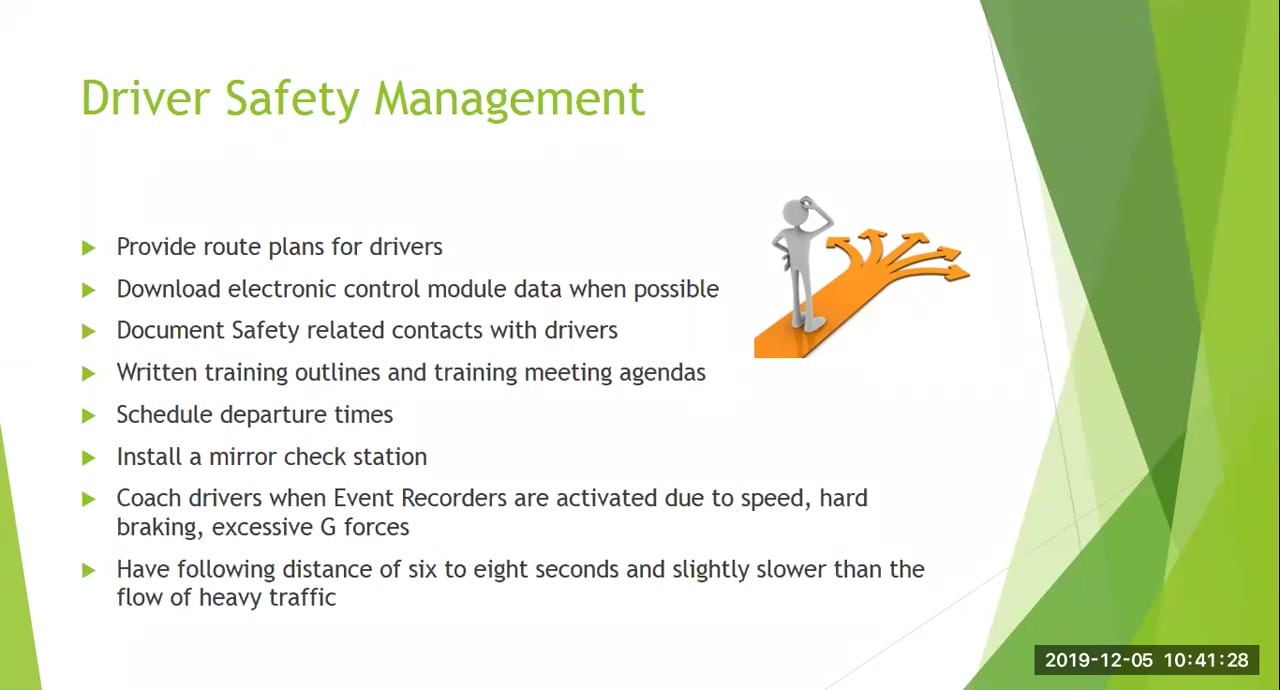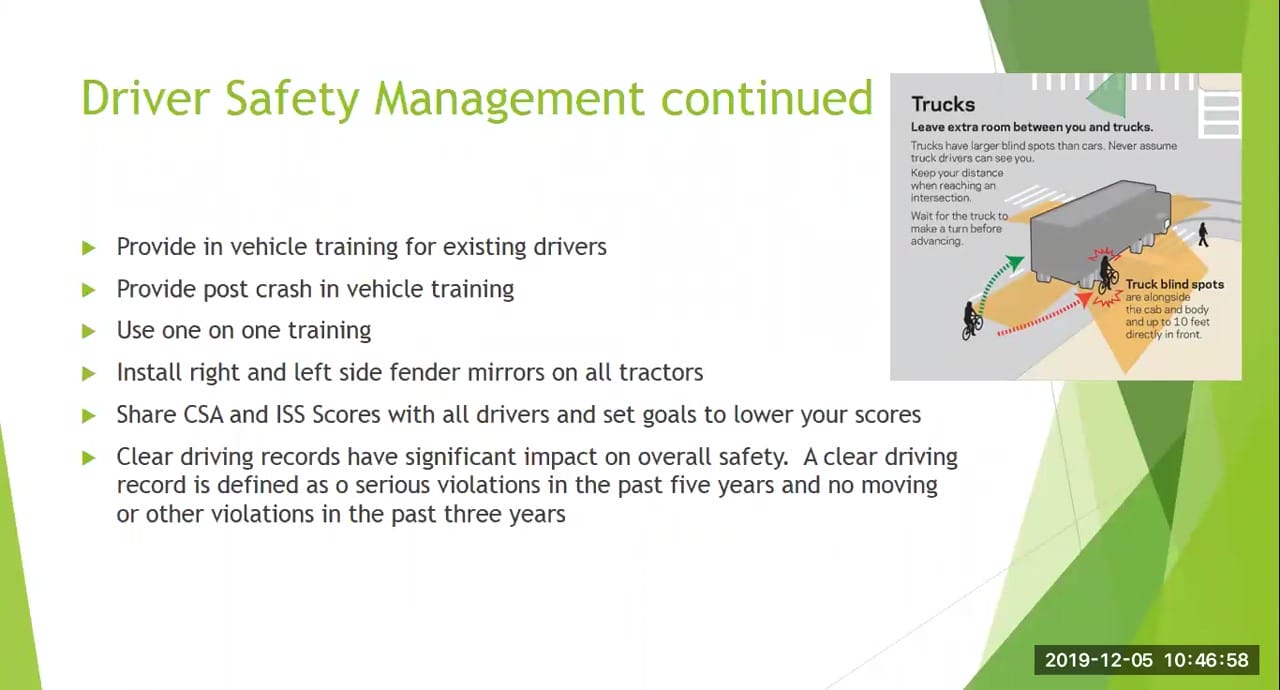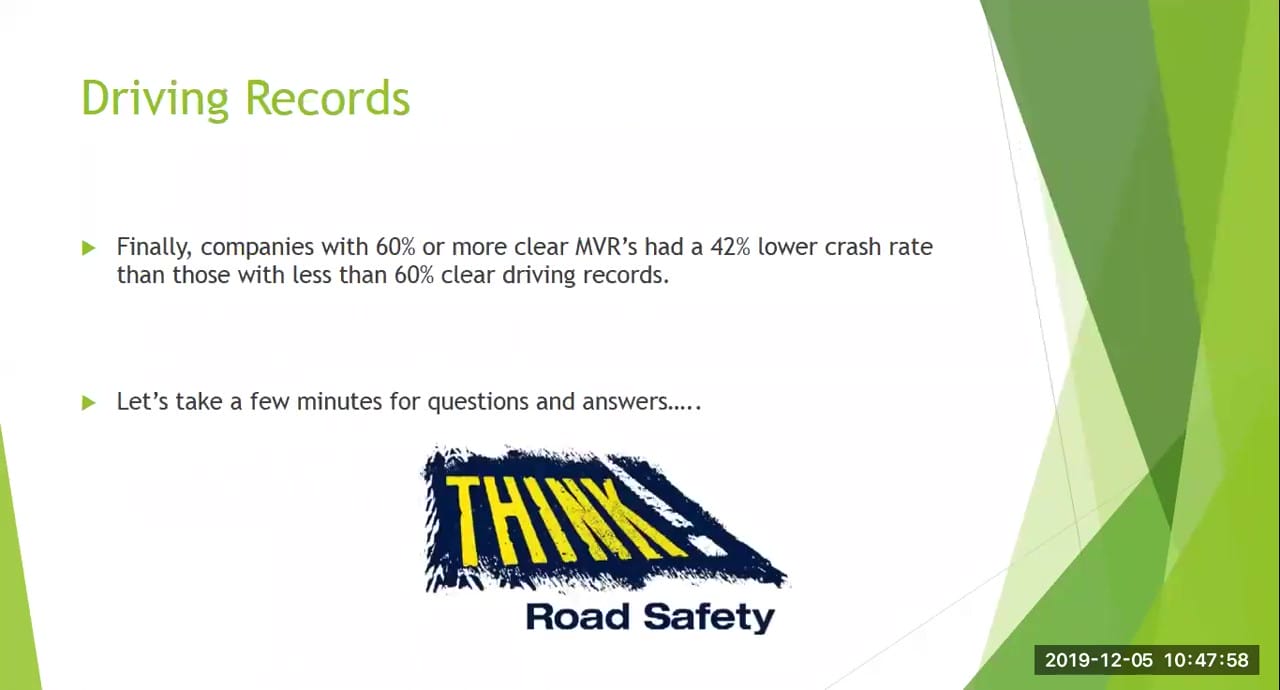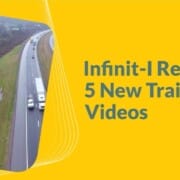Transcription
1
00:00:04.770 –> 00:00:15.780
Steve Kessler: Good morning. My name is Steve Kessler, and welcome to today’s Transportation Industry Best Practices Webinar sponsored by the Infinit-I workforce system and Vertical Alliance Group.
2
00:00:16.859 –> 00:00:24.210
Steve Kessler: Today’s topic is trucking industry best practices. What are the major characteristics of the best trucking companies.
3
00:00:24.930 –> 00:00:31.230
Steve Kessler: But before we get started I’m going to share with you one thing about Vertical Alliance Group and the Infinit-I Workforce Solution.
4
00:00:31.890 –> 00:00:41.190
Steve Kessler: We are the online training company dedicated to empowering and streamlining safety programs for transportation companies across the United States.
5
00:00:41.880 –> 00:00:51.390
Steve Kessler: With over 850 plus training videos, and a customizable system, to automate, track, and document all aspects of training.
6
00:00:51.870 –> 00:00:56.910
Steve Kessler: It’s no wonder more than 2000 companies have chosen the Infinit-I Workforce Solutions.
7
00:00:57.660 –> 00:01:04.470
Steve Kessler: The Infinit-I Workforce Solution not only makes it easy to build an affordable best in class training program for your drivers.
8
00:01:04.980 –> 00:01:13.110
Steve Kessler: But it also frees up your administrative time giving you the ability to communicate more effectively and train employees anywhere, anytime
9
00:01:14.100 –> 00:01:21.990
Steve Kessler: So if you’re committed to having a training program that proves you value safety over profits but all the while still improving your bottom line.
10
00:01:22.410 –> 00:01:29.640
Steve Kessler: type the words training in the Q&A box on your screen. And one of our senior training specialist will reach out to you.
11
00:01:29.970 –> 00:01:37.050
Steve Kessler: And share how the Infinit-I online training system can streamline your entire safety program while making your job easier.
12
00:01:37.920 –> 00:01:44.730
Steve Kessler: Also after the webinar or you will all be receiving an email that will give you a link to a webinar replay.
13
00:01:45.600 –> 00:01:56.670
Steve Kessler: That way you can share today’s program with others that couldn’t attend today and also will also be sending out a copy of the PowerPoint that will be used in today’s presentation. So you’ll
14
00:01:57.210 –> 00:02:10.080
Steve Kessler: have those bullet points. Now, I would like to introduce all of you to our speaker today. Our guest today is Bob Perew, who’s a senior loss control specialist for Canal Insurance Company.
15
00:02:11.220 –> 00:02:20.460
Steve Kessler: Bob has over 45 years of trucking and insurance experience starting out as an independent owner, operator with land star and then becoming a fleet owner
16
00:02:21.210 –> 00:02:26.790
Steve Kessler: He became a safety manager at Landstar and later became the director of training and orientation.
17
00:02:27.780 –> 00:02:40.470
Steve Kessler: After 20 years he moved over to the insurance industry becoming a loss prevention specialist and quickly moved up to the ranks vice president of risk management and safety of a large trucking insurance company.
18
00:02:41.370 –> 00:02:47.430
Steve Kessler: After a short retirement. He went back to work as a senior loss prevention specialist with Canal Insurance Company.
19
00:02:48.420 –> 00:03:00.030
Steve Kessler: Bob attended Indiana University Kelley School of Business. Bob is a certified director safety through the NATMI program and also a certified transportation risk specialist
20
00:03:00.540 –> 00:03:08.910
Steve Kessler: Through the Motor Carrier Insurance Education Foundation. So without further delay, Bob, I’m going to turn it over to you welcome this morning.
21
00:03:10.320 –> 00:03:28.050
Bob Perew: Well, thank you, Steve. And welcome everybody to the webinar this morning. It’s really nice to have a great audience and we want to talk about what really makes trucking companies. Good. And what makes them better. And what we can do to help
22
00:03:29.700 –> 00:03:36.810
Bob Perew: Characterize those trucking companies that seem to excel in our environment today so
23
00:03:37.830 –> 00:03:59.400
Bob Perew: We’re always looking at the management to see what kind of leadership, you have and if the leadership works from the top all the way down with their employees or their owner operators, we like to see very strong and consistent management as we go.
24
00:04:00.420 –> 00:04:07.230
Bob Perew: Look at the best practices of these trucking companies positive attitude is so important.
25
00:04:07.860 –> 00:04:20.280
Bob Perew: Especially from the owner of the company and the safety director. It’s always nice to know that the safety director in the owner, have a good relationship and they can discuss things
26
00:04:21.120 –> 00:04:30.690
Bob Perew: amongst each other about drivers about the company about safety issues that pop up from time to time.
27
00:04:31.470 –> 00:04:39.840
Bob Perew: We also like to see companies that have been in business for five or more years. And that is basically based on the
28
00:04:40.500 –> 00:04:59.820
Bob Perew: Industry standards in terms of, you know, you get a brand new trucking company out there, new entrant, they may not have the experience developed yet to be where we would like to see him as an insurance company. So it’s also important that they have good
29
00:05:00.990 –> 00:05:13.170
Bob Perew: Financials and they don’t skimp on things and spend the money in the right places we always had believed on the risk management side of that.
30
00:05:13.710 –> 00:05:24.120
Bob Perew: If you spend enough money on safety that you’re going to have a really good trucking company. And before I go any further, I’d like to introduce a couple of
31
00:05:24.630 –> 00:05:32.280
Bob Perew: Senior lost control specialists that I have the honor of working with every day. Susan Ogle. She’s our senior loss.
32
00:05:32.910 –> 00:05:40.020
Bob Perew: Prevention specialist and has over 25 years of safety experience. And then I added a routine.
33
00:05:40.410 –> 00:05:53.070
Bob Perew: Who is also a senior lost control specialist. And again, David’s got close to 30 years they’ve lost control of experience. So there’s a lot of lost control and safety experience here so
34
00:05:53.400 –> 00:06:06.000
Bob Perew: At the end of the program. If you do have any questions, please let us know and and into your computer so we can answer those questions for you. Okay, moving on.
35
00:06:07.740 –> 00:06:20.460
Bob Perew: I go ahead, then I’d like to piggyback on your, your opening statement here. I think one of the measurements when I walk in and sit down with an insurance is
36
00:06:21.180 –> 00:06:31.320
Bob Perew: I’m looking at that culture accountability in buying and determining how successful they are kind of piggybacks on your new statement.
37
00:06:31.800 –> 00:06:54.870
Bob Perew: Yeah, and and it’s important that you know the first impression that we get can be a lasting impression and and we visit a lot of trucking companies, day after day, and some good, some bad and we want to share this morning with you. What does make a trucking company. Good.
38
00:06:56.760 –> 00:07:05.010
Bob Perew: The standards that we look for budget for fleet safety to include the following. Do you have a recognition program.
39
00:07:05.760 –> 00:07:22.200
Bob Perew: Tied to driver performance. Do you give your drivers safety awards annual bonuses and do you reward your drivers for good roadside inspections and I see that happening more and more all the time and
40
00:07:22.830 –> 00:07:34.830
Bob Perew: You know, I see a lot of companies given $100 for a clean roadside inspection clean driving records are very important and I know his NBA ours are sometimes
41
00:07:36.060 –> 00:07:40.200
Bob Perew: Really hard to get over, especially if there’s a
42
00:07:41.580 –> 00:07:51.390
Bob Perew: You know, bad driving record in terms of speeding 15 and over over the limit, things like that can really make an NPR look bad.
43
00:07:52.080 –> 00:08:00.630
Bob Perew: Do you have a fuel mileage bonus. And how do you pay drivers for accident free driving, year after year after year.
44
00:08:01.260 –> 00:08:15.780
Bob Perew: Susan. Go ahead. Yeah. Also, when he mentioned the consistent practice in the previous slide, all of these things would be pertinent to practicing everything consistently regardless of
45
00:08:16.800 –> 00:08:24.810
Bob Perew: Relationship family member, whoever it is in your organization consistency in what you say and what you do.
46
00:08:25.080 –> 00:08:44.070
Bob Perew: And how you practice that what’s written needs to be practiced consistently through across the board of all staff or employees. Exactly. And I think it reinforces your values as well. And studies show that that positive reinforcement goes a long way and driving performance. Absolutely.
47
00:08:45.090 –> 00:08:49.740
Bob Perew: You know, give me a pat on the back or a cookie, you get more out. I’ll take the cookie.
48
00:08:52.380 –> 00:08:54.990
Bob Perew: As far as a bit business growth itself.
49
00:08:56.580 –> 00:09:08.400
Bob Perew: Moderate growth is okay 15 20% you know is not unusual. What we don’t like to see is a trucking company that will say go from
50
00:09:08.850 –> 00:09:24.870
Bob Perew: 15 trucks to 50 trucks within a very short period of time, let’s say, a year. So, you know, if you manage your growth really well then you’re able to keep up with your safety department and
51
00:09:26.040 –> 00:09:36.300
Bob Perew: And be able to add more people as needed in your growth. And I think you have to understand that growth and how it’s going to impact your ability to
52
00:09:36.930 –> 00:10:02.520
Bob Perew: To really maintain an oversight of your operation and not let that finger off the pulse of the things that are going to contribute to negative trending. So understanding your, your manpower planning in an actually managing this processes. Exactly. So, you know, like I said, if you grow.
53
00:10:03.870 –> 00:10:09.360
Bob Perew: doubling in size and the year you know that’s a huge recipe for disaster and
54
00:10:11.400 –> 00:10:27.360
Bob Perew: I hate to interrupt. I think one of the other things that you really is really important is also looking at your internal bench strength, making sure that you have the right people in place that are subject matter experts.
55
00:10:28.470 –> 00:10:42.150
Bob Perew: That can help you control and manage that deafness and. And another thing is, you know, if you’re a 15 unit trucking company and you’re going to your want to grow.
56
00:10:42.600 –> 00:10:57.870
Bob Perew: 1015 more units. And you might think, Oh, wow. My insurance companies really gonna like this. We’re gonna double. We’re going to give more premium and everything. Well, that’s not what insurance companies like to see they like to see very very slow growth.
57
00:10:59.070 –> 00:11:02.610
Bob Perew: As 15 to 20% and no more than that. So,
58
00:11:03.930 –> 00:11:07.050
Bob Perew: You know growth is very important and how you grow.
59
00:11:09.180 –> 00:11:20.730
Bob Perew: Now this is something that we always want to talk about, because this has become such a standard in our industry is the CSA and SMS scores, and I believe
60
00:11:21.540 –> 00:11:33.720
Bob Perew: We as a panel here, we believe that trucking companies who understand CSA and SMS have a much better vision of how to run their safety department.
61
00:11:34.680 –> 00:11:43.800
Bob Perew: I wouldn’t recommend that any safety person that’s listening this morning should get us familiars
62
00:11:44.370 –> 00:12:00.030
Bob Perew: Familiarize as they can with CSA an SMS understand those seven basics month safe driving hours of service vehicle maintenance control substance driver fitness trashing indicator hazardous material compliance.
63
00:12:00.750 –> 00:12:13.440
Bob Perew: From the insurance side when we see unsafe driving and hours of service violations underwriters have a very, very tough time dealing with that.
64
00:12:14.610 –> 00:12:21.690
Bob Perew: Insurance companies actually ate the unsafe driving because that’s the area where you’re going to have
65
00:12:22.170 –> 00:12:30.510
Bob Perew: More crashes because of drivers who consistently show up on your unsafe driving category. And if they
66
00:12:31.050 –> 00:12:40.530
Bob Perew: Show up time after time after time, what are you doing with those drivers are you putting them on probation. Are you trying to retrain those folks.
67
00:12:41.040 –> 00:12:50.220
Bob Perew: What exactly should you do when you have a driver that gives you a ticket and say, Hey, you know, I just got caught for speeding.
68
00:12:51.210 –> 00:13:03.960
Bob Perew: I think it’s also really important to understand burn getting granular on this understand the root causes of what is contributing to these received violations.
69
00:13:04.500 –> 00:13:23.190
Bob Perew: Or particular driver behaviors and tie that back to more of an inward reflection on maybe you have operational influences that are contributing to these received violations or maybe it’s a cultural issue.
70
00:13:24.390 –> 00:13:36.630
Bob Perew: Adding on to that. I think that it just dovetails into being proactive because you don’t want to be in a reactive state when something does happen, you have the claim. You have the accident.
71
00:13:37.050 –> 00:13:47.220
Bob Perew: Because of the litigation is going to file follow with any of that. And the more documentation that you have as being a proactive and and
72
00:13:48.480 –> 00:14:06.510
Bob Perew: And documenting what you’ve done. When you have these problems and trying to improve performance and behaviors is extremely critical when it comes to any sort of litigation and just helping people to learn and and to reduce similar losses in the future.
73
00:14:07.740 –> 00:14:31.140
Bob Perew: Okay, moving on. I assess doors. I’m sure you all are pretty familiar with that the ideal score in our opinion would be 50 or below which means that if you go through an inspection station or a way station, it would be up to the officer to
74
00:14:33.000 –> 00:14:39.360
Bob Perew: Either pony around back. But in most cases it’s a pass of anything at 50 or below.
75
00:14:40.440 –> 00:14:52.560
Bob Perew: 74 and below is acceptable if anything above 74 it’s a mandatory inspects of the the OT officer has time, you will probably ask you
76
00:14:53.040 –> 00:15:05.460
Bob Perew: To pull around back and prepare for a deity inspection. So use those as guidelines, if you will, 74 and above. You don’t want to dwell in that area.
77
00:15:06.270 –> 00:15:19.860
Bob Perew: Good trucking company is usually always under 74 and you’re really, really good companies are at 50 or below. If your ISS score starts creeping up
78
00:15:20.760 –> 00:15:33.120
Bob Perew: Take a look to see what you can do to bring it back. Now the duration of the alerts are important and make sure that you trend down and not trend.
79
00:15:34.590 –> 00:15:38.490
Bob Perew: As far as a good direct characteristics of a trucking company.
80
00:15:39.780 –> 00:15:40.620
Bob Perew: Additional break
81
00:15:41.760 –> 00:16:00.240
Bob Perew: It wants to achieve that conditional rating. It doesn’t help you at all with your insurance premiums and it doesn’t help you at all when the D. O. T. Officer pulls you over and they see that that conditional rating on their computers.
82
00:16:01.440 –> 00:16:03.150
Bob Perew: You know, and I think if you have
83
00:16:04.650 –> 00:16:21.540
Bob Perew: A conditional safety rating or you are working to address category alerts. I, I always recommend having another set of eyes on that and drafting a fleet safety plan.
84
00:16:22.650 –> 00:16:28.920
Bob Perew: To to effect a reduction in that and it’ll help you plan out your
85
00:16:30.660 –> 00:16:39.060
Bob Perew: Your attack plan to reverse that trend now it’s easy to explain. Then that you’ve identified in your reacting. Exactly.
86
00:16:41.250 –> 00:16:47.610
Bob Perew: A strong safety culture obviously good hiring practices, a lot of trucking companies.
87
00:16:48.150 –> 00:16:58.410
Bob Perew: Have trucks setting up against the fence that they can’t fill simply because they can’t find the right driver. So if you have trucks setting.
88
00:16:58.890 –> 00:17:06.720
Bob Perew: And you can’t find the right driver, then maybe you ought to take a look and see what’s going on out there.
89
00:17:07.650 –> 00:17:24.990
Bob Perew: It depends on the geographic area of the country because in some areas drivers are a lot easier to find than others, but you know have those hiring practices in place have a driver hiring policy that
90
00:17:26.130 –> 00:17:30.540
Bob Perew: You can put on the internet. If you’re hiring hiring at all for the Internet.
91
00:17:31.680 –> 00:17:37.230
Bob Perew: Have good driver training and safety discipline policies in place and
92
00:17:37.920 –> 00:17:51.900
Bob Perew: Whatever you do, do never deviate from your safety policies if it’s in writing. You want to make sure you follow those policies we would rather see you not have a policy and writing
93
00:17:52.260 –> 00:18:00.270
Bob Perew: Than to violate your own policies and that comes up so many times in litigation and that’s
94
00:18:01.050 –> 00:18:08.100
Bob Perew: You know, you can have a crash and not be your fault, but if there’s anything that doesn’t look good from the
95
00:18:08.610 –> 00:18:22.410
Bob Perew: safety policies or driver hiring guidelines. Let’s say you may have hired that driver that you went outside of your hiring guidelines, then you just violated your own policies. Okay.
96
00:18:23.070 –> 00:18:38.550
Bob Perew: Low driver turnover and I know this is a big hot button in the industry. We like to see less than 20% and I know there’s many of you out there that may have 100% driver turnover by 20%
97
00:18:39.480 –> 00:18:50.010
Bob Perew: Is a good practice to have happen thorough orientation process and what we mean by that, a lot of times we’ll ask a
98
00:18:50.430 –> 00:19:01.740
Bob Perew: Trucking Company. Well, tell me a little bit your orientation process and they’ll say, Well, you know, we get to drive ran for a couple of three hours and explain to them what they need to do. And that’s it.
99
00:19:02.700 –> 00:19:16.830
Bob Perew: Maybe that’s not enough. I think for a good practice at least the full day of orientation to include some safety practices and some safety topics for the driver to push that
100
00:19:18.450 –> 00:19:22.320
Bob Perew: Bob, I’m going to piggyback on this because this is an area that I have a lot of passionate
101
00:19:23.790 –> 00:19:34.620
Bob Perew: So when I hire someone, I want to set the performance expectations to begin with. I want this relationship deal long lasting relationship.
102
00:19:35.790 –> 00:19:36.270
Bob Perew: And
103
00:19:37.590 –> 00:19:41.520
Bob Perew: Case studies over the years have indicated that training.
104
00:19:42.690 –> 00:19:52.050
Bob Perew: Effective training leads to good driver performance. So if you hire someone and you saturate them with defensive driving skills.
105
00:19:52.590 –> 00:20:16.830
Bob Perew: And you do it. We iteration of the FM CSA rules and regulations going to kind of fill a gap that has not really been effectively conducted throughout the industry and you’re going to lower that exposure to future claims and violations, both of which affects your premiums.
106
00:20:18.240 –> 00:20:35.700
Bob Perew: Okay and and going off of that setting those expectations and you’re heading this during an orientation and you have to understand and remember that people are inundated with information at higher they are hearing
107
00:20:36.840 –> 00:20:39.990
Bob Perew: You know, blah blah blah cents per mile, blah, blah, blah.
108
00:20:40.770 –> 00:20:48.660
Bob Perew: Vacation, blah, blah, blah. Whatever. So if you can get those people back in there to reiterate those expectations.
109
00:20:48.930 –> 00:20:57.300
Bob Perew: If it’s if it’s in two weeks or whatever time frame you deem necessary but get them back in there and remind them. This is our disciplinary policy.
110
00:20:57.600 –> 00:21:07.110
Bob Perew: This is what we are expecting of you. And do you have any questions or are you having any difficulty and how, how are you, how are they communicating with dispatch, etc.
111
00:21:07.560 –> 00:21:16.320
Bob Perew: You know, how are they doing under vehicle maintenance reports and the pre and post so get them back in any other thing when Bob mentioned the
112
00:21:16.830 –> 00:21:25.530
Bob Perew: safety policies do not, under any circumstances, select and take someone else’s saved policy and put your name on front of it.
113
00:21:25.890 –> 00:21:36.780
Bob Perew: You need to tailor policies after your own operations. Do you even know points. Yes. Do you know what’s in that policy, because whatever you have. You are held responsible and accountable to
114
00:21:37.080 –> 00:21:51.150
Bob Perew: under any circumstance, and it may even have names in there are people that aren’t even within your within your organization. So each sure and Taylor, anything that I don’t that’s specific to you and do not have
115
00:21:52.530 –> 00:21:58.800
Bob Perew: Things that are fluff. You know, you don’t need in there just have what you need and how you need it.
116
00:21:59.190 –> 00:22:09.270
Bob Perew: According to your company, your expectations and I’m really big on driver orientation, simply because of two reasons. Number one, you have a captive audience at that time.
117
00:22:09.960 –> 00:22:23.610
Bob Perew: Chances are if you do a three hour orientation and he gets out on the road. It may be a long time before you get them back in. So try to get as much covered. You know, like drug and alcohol testing safety practices.
118
00:22:24.870 –> 00:22:29.730
Bob Perew: Teaching the driver about your own policies.
119
00:22:30.870 –> 00:22:48.570
Bob Perew: Everything that he needs to know to equip him with as much information as he needs to do a good job. That’s why I’m orientation is so important. And that’s a question that we ask when we visit our clients do you have an orientation program. And how long does it last. You know, so
120
00:22:49.770 –> 00:22:59.070
Bob Perew: Three hours just sometimes just isn’t enough because we are truly invest in in the success of this employee.
121
00:23:00.030 –> 00:23:11.460
Bob Perew: In our organization that was no longer. Yeah, we can keep them in our organization, the more successful. They’re going to be any more profitable. The care is going to be
122
00:23:12.060 –> 00:23:23.400
Bob Perew: On the safety side customer service vehicle maintenance. It’s going to build an employee buy into our program. Well, another thing, you know.
123
00:23:23.850 –> 00:23:32.370
Bob Perew: Outside of the orientation is newer equipment. A lot of drivers like to drive new stuff, you know, I like to drive a new car. Every time I get a chance
124
00:23:32.850 –> 00:23:41.010
Bob Perew: I just love the smell of a new car, you know, drivers like newer equipment. I’d like clean equipment well maintained equipment.
125
00:23:41.610 –> 00:23:45.180
Bob Perew: Automatic transmissions. As you see here on the PowerPoint presentation.
126
00:23:45.870 –> 00:23:59.220
Bob Perew: Is actually been proven that the accident frequency has gone down by as much as 15% with companies using automatic transmissions, you know, and it’s funny that you bring that up, Bob, because you know I learned
127
00:23:59.520 –> 00:24:13.650
Bob Perew: On a 400 split when I learned how to drive and all of a sudden over the years. Now with automatic transmissions coming in a lot of the lot of mine shirts are telling me that when they’re recruiting
128
00:24:15.720 –> 00:24:22.770
Bob Perew: The driver base that’s coming in. Now that’s been driving for the last, let’s say, five to 10 years they don’t know how to shift the 13th.
129
00:24:24.150 –> 00:24:47.250
Bob Perew: That’s right. They weren’t on automatic transmission, which is amazing. Yeah, that is, and pet peeve here again governor’s set at 68 mile an hour or below. Well, we all know that excessive speed causes accidents and the faster you go, the more fuel, you’re gonna burn so
130
00:24:48.420 –> 00:25:03.150
Bob Perew: Part of our best practices is try to govern your trucks at 68 or below not saying that you got to have them at 60 miles an hour. But if you have a disciplinary problem with a driver, you may want to consider cutting this truck back of it so
131
00:25:04.260 –> 00:25:17.040
Bob Perew: Any other part of that Bob is to make sure that this batch people are aware of this, that they can’t keep pushing drivers and then having them go over hours of service because they’ve done that. And I do want to go back to one thing
132
00:25:17.790 –> 00:25:25.410
Bob Perew: David mentioned, because it is about building a mutual respect and if you give people back in there to reinforce these things and
133
00:25:25.620 –> 00:25:31.200
Bob Perew: How are you doing, and you’re building a respectful rapport with your driver letting them know that
134
00:25:31.470 –> 00:25:44.070
Bob Perew: They are more to you than just someone to put in a driver’s seat and haul things from point A to point B, C and D. They are very important to the organization build on that and let them know how they are valued.
135
00:25:44.670 –> 00:25:58.560
Bob Perew: Hey, I just can’t talk enough about that and it allows you to address Foreman’s issue when it’s small before it becomes large, so that you can in fact driver. Exactly. Yeah.
136
00:26:00.150 –> 00:26:01.740
Bob Perew: Driver compensation.
137
00:26:02.850 –> 00:26:16.950
Bob Perew: That’s always a hot topic, you know, what are, what are we paying our drivers. These days, and we all know that the compensation has increased tremendously over the last two or three years and this is a trend that’s probably going to continue
138
00:26:17.550 –> 00:26:21.690
Bob Perew: To slide upwards, as the driver shortage becomes more of a reality.
139
00:26:23.310 –> 00:26:28.080
Bob Perew: We believe that 40 cents five cents per mile should be the minimum
140
00:26:29.130 –> 00:26:39.390
Bob Perew: Based on what we’re seeing out there but you know a lot of drivers are making even more money than that now additional compensation for stop offs.
141
00:26:39.990 –> 00:26:50.310
Bob Perew: Make sure that you pay your drivers for everything that they do competent compensation for unexpected delays and I know that’s hard to do, but
142
00:26:50.820 –> 00:27:01.590
Bob Perew: A lot of times if a driver gets into customers facility. He may he or she may have to wait hours to get on loaded or to get loaded
143
00:27:02.280 –> 00:27:10.830
Bob Perew: If you have a policy that would help compensate that driver, you know, just a fraction, you know, to make them feel better.
144
00:27:11.520 –> 00:27:21.660
Bob Perew: Is would be a good best practice to us owner operators should receive at least 70% of the gross revenue pulling your trailer and
145
00:27:22.290 –> 00:27:35.190
Bob Perew: In many cases, we’re seeing as much as 80 and 85% of their revenue these days do you offer health insurance. And I know health insurance is very, very expensive and it’s not getting any cheaper.
146
00:27:36.660 –> 00:27:55.410
Bob Perew: If you can provide something close to health insurance is better than having no health insurance at all 401 k plans. Those are actually easy to do. If, if you just want to add 2% to the driver on his
147
00:27:56.790 –> 00:28:13.620
Bob Perew: Very important vacation packages and safe driving bonuses and fuel bonuses the compensation package is probably the most important things that driver look at in today’s especially in today’s economy, wouldn’t you guys agree.
148
00:28:14.880 –> 00:28:24.330
Bob Perew: You know, I would agree. And over the years and actually it’s it varies throughout the region. Yeah. As I travel around its
149
00:28:25.050 –> 00:28:39.420
Bob Perew: compensation packages changed by region by segment of the trend absolutely industry. And I think some of the things that my, my best in class insurance have in common is
150
00:28:40.530 –> 00:28:46.350
Bob Perew: Really the benefits pack health insurer absolute, is it really important vacation.
151
00:28:48.840 –> 00:29:01.410
Bob Perew: A lot of a lot of drivers will look at going to a regional carrier, not because they want to, but because it offers them a good compensation package on health insurance. Oh, absolutely.
152
00:29:02.730 –> 00:29:09.240
Bob Perew: telematics, and I tell you what the electronics out there that drivers have and the telematics
153
00:29:09.600 –> 00:29:22.050
Bob Perew: That they have access to and that you as a fleet owner as a trucking company have access to are just unbelievable. There are so many things that can help you manage your drivers.
154
00:29:22.560 –> 00:29:32.190
Bob Perew: Manage your maintenance, find out what what your drivers are doing. We’re seeing a lot of companies that are using cameras now.
155
00:29:33.180 –> 00:29:43.830
Bob Perew: Both ways where they look inside the truck and outside of that track. Those are very good practices to have if you can get with a company that provides
156
00:29:44.460 –> 00:29:58.290
Bob Perew: Good cameras those costs appear to be going down from what we have seen and the things that cameras can do as far as excessive G forces speeding.
157
00:29:58.830 –> 00:30:05.460
Bob Perew: It gives you another tool to manage your drivers better than ever before GPS systems are
158
00:30:06.390 –> 00:30:19.560
Bob Perew: Are out there that you know i i go in a trucking company and I see these huge big screens. But guess their wall and these dots all over the country, indicating where each and every one of their trucks are
159
00:30:19.830 –> 00:30:28.470
Bob Perew: That is just so nice to see, and then I talked to the dispatchers and he’ll tell me yeah this driver here he’s
160
00:30:29.070 –> 00:30:35.220
Bob Perew: Taken is taking this break right now this driver. Here’s fielding up this driver. Here’s doing this and doing that.
161
00:30:35.520 –> 00:30:47.490
Bob Perew: They did you have it you know I did, I, I’m a big supporter of this especially you know all these safety technologies. But I think the most important aspect of this investment.
162
00:30:48.090 –> 00:31:02.220
Bob Perew: Is to manage the system. Make sure that the system that you implement or invest in that you’re managing the process to identify exposure to make your drivers better
163
00:31:03.120 –> 00:31:12.780
Bob Perew: counseled them based on these triggered events so that you can address an issue when it’s minor detail for it results in a large loss.
164
00:31:14.160 –> 00:31:18.510
Bob Perew: And, you know, it’ll help you again on the retention side and
165
00:31:19.230 –> 00:31:26.970
Bob Perew: It will provide a good return on investment with this technology. Oh, absolutely. And most of us have a yo do these in their trucks now.
166
00:31:27.330 –> 00:31:42.420
Bob Perew: And the good thing about it the LDS can do a lot more than just the logging part of it, you know. So when you’re looking at the oldies see what you can get that majors. Other things that your drivers are doing so you can manage them better.
167
00:31:43.770 –> 00:31:45.060
Bob Perew: Also a lot of
168
00:31:46.080 –> 00:32:08.610
Bob Perew: Your truck manufacturers now coming out with the telematics like Lane Departure systems and collision mitigation technology anti rollover and Electronic Stability technology. One important aspect that I see in working when you’re looking at some of this safety technology.
169
00:32:10.440 –> 00:32:15.900
Bob Perew: There thought that it’s compatible with your operational software that you’re using internally.
170
00:32:16.350 –> 00:32:34.710
Bob Perew: So it’s an ease of use throughout your, your operations. So, and, and one other thing on that is make sure that you do not sign into any contract until you have actually had a chance to try this, that, that’s a really good point. Susan because you can get
171
00:32:35.790 –> 00:32:44.970
Bob Perew: Sucked into a deal that you’re thinking, Man, I do. I want to get out of this. Yeah, a lot of your camera companies. They want you to sign that three year contract, you know,
172
00:32:45.750 –> 00:32:51.660
Bob Perew: A lot of accounts that have gotten right they dug and dug a hole there and they have to wait for that contract to
173
00:32:52.380 –> 00:32:57.900
Bob Perew: Be able to pick up a different piece of equipment so sure be very cautious about that and
174
00:32:58.260 –> 00:33:08.700
Bob Perew: Because many of those you’re able to set your own thresholds so that you’re not, you know, people will say, oh, that kind of picked me up every time I hit a hard break or whatever. But you can set thresholds or
175
00:33:09.000 –> 00:33:19.380
Bob Perew: Hard turns breaking and things like that will go off on certain so i just i guess you want to do a little trial dating before you enter into this relation to absolutely
176
00:33:20.250 –> 00:33:28.830
Bob Perew: One of the other things that you may want to consider if you don’t want to get in with a big company that provides the telematics for cameras is
177
00:33:29.280 –> 00:33:49.620
Bob Perew: You can buy these cameras at a truck stop now for for 30 to $50, you know, a camera, no matter how cheap it is is better than no camera at all because you want to be able to prove your innocence. If you’re ever involved in in a crash and also
178
00:33:50.850 –> 00:34:00.960
Bob Perew: Also it’s it’s even fine if it is our fault if it’s the driver’s fault that your claim scheme can get in there quickly and try to keep
179
00:34:01.230 –> 00:34:07.740
Bob Perew: Emotions, a lot more calm before they start going out and lawyer enough and to say hey you know what we see that this is
180
00:34:08.520 –> 00:34:18.690
Bob Perew: Our problem. So we’re going to go ahead and handle this before they get in there and people can stay calm and so either way. Very good point. So, yeah, yeah.
181
00:34:19.650 –> 00:34:33.030
Bob Perew: As far as driver trainings concerned use driver training programs and another driver training aids because training, training. Training is probably the most important things that you can do with your drivers.
182
00:34:33.360 –> 00:34:44.220
Bob Perew: Even your most senior drivers who have one, two, or 3 million miles need to be retrained from time to time, we call it like a remedial training program.
183
00:34:44.550 –> 00:34:54.750
Bob Perew: Have that in place for your senior drivers and now also use your senior drivers to help mentor, you’re young.
184
00:34:55.470 –> 00:35:08.790
Bob Perew: And newer drivers and here’s the thing, as far as hiring new drivers and they don’t have to be brand new. They could be experienced drivers. But I’m talking about any driver. They to get that net walks through your front door.
185
00:35:09.210 –> 00:35:19.590
Bob Perew: Take him for a road test longer road tests, as proven in the past to reduce backing accidents by as much as 15% now that
186
00:35:20.070 –> 00:35:33.360
Bob Perew: Yeah, you know, and I know my whole audience out here. You guys have all had your share of backing accidents and more you do with your drivers, when you have them.
187
00:35:34.230 –> 00:35:46.680
Bob Perew: on on the on the driver test testing your driver on the road test more you find out about not only how he drives. But you find out a little bit about his personality. So we bring
188
00:35:49.140 –> 00:35:57.840
Bob Perew: In during that road test that is the best that driver will drive because it’s been observed another trek
189
00:35:58.800 –> 00:36:07.530
Bob Perew: That’s common and industry if you’re able is to do what you would call like a safety five or later on fall back drive around and around.
190
00:36:08.100 –> 00:36:16.050
Bob Perew: Covering your observer and the observed that drivers behaviors and see if he lives up to your performance safety standards.
191
00:36:16.350 –> 00:36:23.010
Bob Perew: And one more thing using your in house knowledge base and the skills of the more experienced drivers.
192
00:36:23.250 –> 00:36:33.270
Bob Perew: They’re going to go out there and they’re going to want to succeed, and they are not going to want to go against what they just taught someone else. So you’re going to be building that
193
00:36:33.810 –> 00:36:45.870
Bob Perew: Foundation, also a little stronger foundation from that perspective, one of the largest trucking companies that I know they drive Barrett Brown trucks. If any of their drivers have had an accident.
194
00:36:46.410 –> 00:36:57.840
Bob Perew: The safety manager or safety person that next day will go out with that driver to do an evaluation. So to me, that’s a really good best practice, it’s something
195
00:36:58.410 –> 00:37:14.550
Bob Perew: That you can nip it in the bud right away to ensure that those types of problems don’t happen in the future, little maintenance. But I’ll tell you what we spent a lot of money annually on vehicle maintenance and I know this is a tough subject and
196
00:37:15.690 –> 00:37:32.160
Bob Perew: You know, you got policies in place involve your mechanics in your overall safety program. Make sure your equipment is inspected daily, weekly, and monthly. Make sure that your drivers do a walk around.
197
00:37:33.330 –> 00:37:42.450
Bob Perew: Every time they get to their truck, you know, and yet you can go do a fuel stop and while you’re fueling your truck do a walk around.
198
00:37:43.110 –> 00:37:57.480
Bob Perew: Hit the tire see what’s going on, ensure that you have certified vehicle mechanics. I know the deal T likes to see mechanics, who are licensed and certified. So whoever works on your trucks.
199
00:37:58.410 –> 00:38:10.410
Bob Perew: Make sure those guys know what they’re doing. Reward mechanics. This is a big topic. To me, the more you involve your mechanics and get them to understand your SMS scores.
200
00:38:11.190 –> 00:38:15.750
Bob Perew: And and give them a reward, just in the pat on the back, just like you do your drivers.
201
00:38:16.230 –> 00:38:30.330
Bob Perew: The big things out there that we see our tires lights and breaks. Those are the three major components that drivers always get thing for yeah so I would like to also say that mechanics are not sitting there.
202
00:38:32.190 –> 00:38:37.020
Bob Perew: In front of a crystal wall thinking oh gee I wonder what’s wrong with unit number 649
203
00:38:38.010 –> 00:38:54.150
Bob Perew: People need to communicate and need to keep that communication exact driver dispatch using SMS scores but that communication that there’s a breakdown in one of those three areas, your, your vehicle could be missing something very critical.
204
00:38:55.410 –> 00:39:01.050
Bob Perew: But it’s just because of a lack of communication, right, then let’s talk about our driver selection real quick.
205
00:39:01.890 –> 00:39:09.420
Bob Perew: Make sure that you hire drivers with clear driving records the cleaner. They’re driving record, the less likely that driver is to have a serious
206
00:39:09.990 –> 00:39:18.750
Bob Perew: serious accident in the future, we would like to see a minimum of six months probation period for anybody that comes drives
207
00:39:19.410 –> 00:39:26.880
Bob Perew: For your company and and depending on what your MBA or looks like. You may even go out full year on your
208
00:39:27.720 –> 00:39:42.390
Bob Perew: Probation road test for two hours or longer. And I know that sounds like a long time. But again, like we said earlier, the longer you spend with your driver, the more you can learn about this person so
209
00:39:42.930 –> 00:39:53.340
Bob Perew: To have a road test to me is not that excessive if you can afford to do that, by all means do that based on recent studies by a try.
210
00:39:53.910 –> 00:40:00.570
Bob Perew: New drivers that are road tested for excessive amount of times are less likely to have serious crashes.
211
00:40:01.410 –> 00:40:12.900
Bob Perew: That’s a big one. Folks that that that is really, really big good trucking company companies perceive that good driver selection is the strongest part of your safety program.
212
00:40:13.560 –> 00:40:19.890
Bob Perew: And this is what makes up good characteristics of what we consider very good trucking company.
213
00:40:20.820 –> 00:40:32.460
Bob Perew: So your overall driver safety management and this, in my opinion, includes everybody in your company from the top all the way down to the person that cleans your shop area. Okay.
214
00:40:33.270 –> 00:40:41.130
Bob Perew: Provide route plans for drivers don’t always assume your driver knows exactly what route. He needs to take understand
215
00:40:42.150 –> 00:40:42.840
Bob Perew: If there’s
216
00:40:44.070 –> 00:40:51.750
Bob Perew: Necessary mileage that is being driven because the route planning is not done properly.
217
00:40:53.190 –> 00:40:54.810
Bob Perew: Hey, Bob, I’m going to jump in on this one.
218
00:40:56.100 –> 00:41:20.880
Bob Perew: So if, if you’re servicing a regular customer base right books are an excellent form of of making a new driver familiar with a route in will allow you to identify noon hazards in that route or on site, and that includes low bridges and then he kind of
219
00:41:21.960 –> 00:41:25.380
Bob Perew: Crashes or road construction or anything down the road.
220
00:41:26.940 –> 00:41:30.420
Bob Perew: A little bit more familiar with turkeys in a go.
221
00:41:31.830 –> 00:41:40.950
Bob Perew: Which which reduces some of that, and especially with the regional drivers. Now when when you get these guys that do the short house. You know, it’s not
222
00:41:41.400 –> 00:41:50.760
Bob Perew: Not as bad but download electronic information as much as you can document safety related contracts with drivers.
223
00:41:51.300 –> 00:42:00.000
Bob Perew: Document everything that you do and leave a paper trail, because if you ever get audited by do it, you’re, you’re going to want to show that, hey, we’ve
224
00:42:00.570 –> 00:42:13.260
Bob Perew: Done this and done that with the driver have written training outlines and training meeting agendas, if you do any safety meetings and I know this. A lot of trucking companies are getting away from safety meetings.
225
00:42:13.830 –> 00:42:22.560
Bob Perew: They’re doing these electronically. Now I don’t have a big problem with it. But every once in a while, you know, it’s good to have the drivers all get together and
226
00:42:23.010 –> 00:42:37.140
Bob Perew: Have have a guest speaker, there may be maybe a speaker from your insurance companies safety group. I know that we’ve done that in the past. So that’s always nice to have somebody
227
00:42:38.430 –> 00:42:49.050
Bob Perew: From the outside, talk to your drivers about what’s going on. Well, again, you’re building a relationship with your teammates for longevity.
228
00:42:49.800 –> 00:42:56.580
Bob Perew: And they’re learning from one another. I think that that whole thing about trying to get people together for a meeting. I know that it’s difficult that
229
00:42:56.850 –> 00:43:04.800
Bob Perew: In some way, shape, or form to share that information, especially when it comes to route planning. Maybe someone got shipped from one route to another route.
230
00:43:05.100 –> 00:43:14.640
Bob Perew: Well you know what, hey, maybe there’s a low hanging of building here and and it’s easy to pick that off, unless you go around the other way, or whatever it might do.
231
00:43:14.880 –> 00:43:25.320
Bob Perew: There are things that only a driver who has made that route before is going to be familiar with and and it’s good just helpful information and sharing that information that knowledge base.
232
00:43:25.980 –> 00:43:35.730
Bob Perew: Another thing is scheduled departure times and not tell you why I’m saying that a lot of drivers. They love to wait until the last minute to leave and
233
00:43:36.300 –> 00:43:51.030
Bob Perew: You know, let’s say they want to be at home with the family on Sunday and they probably leave at 1011 O’clock Sunday night that’s going to create a bad environment for the driver because he may have further to go and
234
00:43:51.810 –> 00:44:02.100
Bob Perew: You know, it may not get there in a timely manner. So that creates a lot of problems. And I think that’s an area that been, you know,
235
00:44:02.790 –> 00:44:23.700
Bob Perew: Most major office settings. That’s an area that is taught and retort numerous time is proper time management. Yeah, absolutely. And talking about time management. We don’t have a whole lot of time left. So we’re going to try to get through this presentation just as fast as we can, folks.
236
00:44:25.020 –> 00:44:37.200
Bob Perew: Again, like I said, a good practice is to schedule departure times if you can. And I know not all of you guys can do that. Install a marriage check station. And what I mean by that is on your
237
00:44:39.180 –> 00:44:49.440
Bob Perew: Facility, you can actually draw a line where a truck and pull up to and have his mirrors set based on what that check station does for you.
238
00:44:50.250 –> 00:45:00.750
Bob Perew: There you can go on the internet and find out. Mayor check station Google and it’ll show you how to set set up one. It’s not very expensive. All it takes is a little bit of paint.
239
00:45:01.680 –> 00:45:08.010
Bob Perew: Coach drivers went to MIT recorders are are activated do the speed heartbreaking and excessive.
240
00:45:08.460 –> 00:45:19.890
Bob Perew: Forces and I know a lot of you are doing that. That is a very good practice because once you find out that a driver is trending with a lot of these things.
241
00:45:20.400 –> 00:45:31.200
Bob Perew: Try to get them in and talk to them as safe as quickly as you can have a following distance of 68 seconds and slightly slower than the flow of traffic and
242
00:45:31.680 –> 00:45:40.770
Bob Perew: It’s a good practice to do. And I know in a lot of areas. You can’t do that. You get up in Chicago, you leave a gap and somebody’s going to take it every time you know so
243
00:45:42.840 –> 00:46:02.670
Bob Perew: Following distances important because if you have bad following distances and and one of the biggest things when we see a regulations and folks riparian collisions cost a lot of money for your insurance carrier and somebody always seems to get that hurt and to get hurt bad
244
00:46:04.260 –> 00:46:14.880
Bob Perew: Provide vehicle in vehicle training for accepting drivers provide post crashing vehicle training use one on one training and
245
00:46:15.360 –> 00:46:21.150
Bob Perew: A lot of times a safety director can do that or even one of your senior drivers can help you do that.
246
00:46:21.540 –> 00:46:32.040
Bob Perew: Install right lane and left lane side fender mounted mirrors. It’s been proven that those fender mountaineers absolutely help reduce losses. Okay.
247
00:46:32.400 –> 00:46:43.440
Bob Perew: Share CSA and I assess scores with all your drivers, let them know what your scores are because it’s the drivers that created those scores and make it
248
00:46:43.800 –> 00:46:51.630
Bob Perew: To where the drivers are going to help you improve those scores, if they know what the numbers are. Then they know what to do about the numbers.
249
00:46:52.290 –> 00:47:04.770
Bob Perew: Clear driving records have a significant impact on overall safety it clear driving record is defined this no serious violations in the past five years, and no moving or or
250
00:47:05.100 –> 00:47:15.150
Bob Perew: Or other violations in the past three years. That’s a clear driving record with man. We love to see those, but unfortunately there’s not that many of math, they’re
251
00:47:16.800 –> 00:47:33.720
Bob Perew: Driving records. And finally, we’re on our last slide. So companies with 60% or more clear NBA ours had a 42% lower crash rate than those with less than 60% clear driving records so
252
00:47:34.440 –> 00:47:45.720
Bob Perew: Steve, I think that’s all we have. This is a time where we have about 10 minutes if anybody has any questions and we’ll open the floor up to you, Steve.
253
00:47:46.380 –> 00:47:59.250
Steve Kessler: Sure. Thanks, Bob. By the way, this is fantastic information. I appreciate all of you, there is a couple of questions. And the first question relates back to, we had conversations I believe about
254
00:48:00.990 –> 00:48:15.210
Steve Kessler: Pay on the drivers and when they asked that you talked about 45 cents. She says that 45 cents. Should that be a base pay or said that include all per diem stop off dropping hook, etc.
255
00:48:16.050 –> 00:48:23.760
Bob Perew: That should be just a base pay 45 cents per mile any other SS Orioles should be added to that Steve.
256
00:48:24.030 –> 00:48:33.930
Steve Kessler: Okay, perfect. Chad’s also asking as it relates to delay pay. How long would you consider before you pay for delays, maybe all
257
00:48:34.290 –> 00:48:35.730
Steve Kessler: About that. Yeah.
258
00:48:35.790 –> 00:48:53.640
Bob Perew: Yeah, usually after a couple of hours. I would start putting an hourly wage to that for that driver and that can be anywhere from let’s say $10 to $15 an hour, but you’re compensating him.
259
00:48:54.120 –> 00:49:03.360
Bob Perew: Or her something for their extra time because two hours delay, you know, if they could be driving at 45 cents.
260
00:49:03.870 –> 00:49:06.330
Bob Perew: Yeah mile that’s that’s a lot of money.
261
00:49:06.960 –> 00:49:07.890
Steve Kessler: Yeah. Sure it is.
262
00:49:08.670 –> 00:49:22.080
Bob Perew: It is negotiated back at the time that the lotus tendered with your shipper yeah and you know you can you can ask the shipper for detention pay as well so
263
00:49:22.500 –> 00:49:40.200
Bob Perew: There’s a lot of things that you can do to help keep your driver because drivers who are always being delayed because of the shipper are constantly, then I know stay with the very low. They’re gonna move on, you go with a company that is going to compensate you
264
00:49:41.460 –> 00:49:47.610
Steve Kessler: Absolutely. There’s another question here. People are a couple of folks have asked this question about
265
00:49:49.680 –> 00:50:01.800
Steve Kessler: It there a, I guess, a benchmark on training frequency safety messaging is is monthly better than quarterly or what we, any thoughts about that. Well,
266
00:50:02.130 –> 00:50:17.400
Bob Perew: Well, you know, studies show that adults learn most effectively through repetition. So I don’t even have to look at your messaging based on your historical and current exposure trend in
267
00:50:18.540 –> 00:50:26.160
Bob Perew: And, you know, sometimes it depends if you’re running an over the road operation you’re not can see your drivers, all the time. I say bare minimum.
268
00:50:26.700 –> 00:50:32.160
Bob Perew: Would we be quarterly at the bare minimum. I like to see monthly but
269
00:50:32.580 –> 00:50:41.820
Bob Perew: You know it’s effective training that matters most. But the biggest thing. Steve that I like to see is get those training topics.
270
00:50:42.120 –> 00:50:50.730
Bob Perew: Out to your drivers, at least on a weekly basis. You don’t want to end a bit inundate them with a bunch of stuff. But if you can have a
271
00:50:51.240 –> 00:51:01.050
Bob Perew: Some kind of safety message once a week to the drivers and then once a month, go into a little more detail and doing some testing.
272
00:51:01.740 –> 00:51:12.870
Bob Perew: wouldn’t be a bad idea at all. You know, so think about that and you want to make sure that everything you do is documented so they know
273
00:51:13.500 –> 00:51:24.060
Bob Perew: Show that you are, in fact, yeah. Putting these kind of measures out there and everything that we’ve talked about this morning is what and
274
00:51:24.720 –> 00:51:39.390
Bob Perew: If trucking companies go by those guidelines and you all are more than welcome to use this PowerPoint presentation, any way that you want. If you go by what you see there it will make you a better trucking company. Yeah, and
275
00:51:39.960 –> 00:51:48.780
Bob Perew: But by by doing that is going to make us safer trucking company and make the training more pertinent to your problems and your exposures.
276
00:51:49.110 –> 00:51:54.360
Bob Perew: And also on the frequency right as following as quickly after you see
277
00:51:54.720 –> 00:52:03.480
Bob Perew: A situation or a bad behavior or or driving habit or whatever as quickly as possible, because then that way, it’s not forgotten. It’s not letting the past or
278
00:52:03.810 –> 00:52:14.730
Bob Perew: An employee is saying all the old man, he’s not going to see it for another month, you know, just, you know, the more closely, you can track things and the quicker that you can call them out. I think is better.
279
00:52:15.060 –> 00:52:25.410
Bob Perew: And if it doesn’t, you know, not calling them negatively. Right. And, you know, we talked about before we got on the call. This morning we were talking about safety videos.
280
00:52:26.130 –> 00:52:43.680
Bob Perew: We like to five minutes safety topics. A lot of drivers love that as well because five minutes is not much of your time. We don’t necessarily want to listen to safety video last 45 minutes to an hour at those five minute training videos are really helpful.
281
00:52:44.820 –> 00:53:01.980
Steve Kessler: Perfect that so that’s kind of how we look at it here in our company, a couple of follow up questions here. I think this also relates to the compensation conversation Sergio was asking, Isn’t all on duty time compensable by law.
282
00:53:05.070 –> 00:53:06.840
Steve Kessler: Well, yeah.
283
00:53:07.290 –> 00:53:09.300
Steve Kessler: Maybe that’s the argument that yeah
284
00:53:09.390 –> 00:53:17.670
Bob Perew: Yeah, yeah. You know, I’m not really a lawyer, but it some good attorney can probably open that up and
285
00:53:18.690 –> 00:53:37.950
Bob Perew: Put a put a lot of thought into it. And yeah, I can see where that would be a problem. So I think that is what has led to see over litigation right to the success also of short training videos like Infinit-I workforce.
286
00:53:39.030 –> 00:53:40.620
Steve Kessler: Because now your driver can
287
00:53:42.150 –> 00:53:52.560
Bob Perew: can receive this training ensure quick increments of 35 minutes that’s easily absorbed and doesn’t cut into that on duty, not driving right
288
00:53:53.550 –> 00:53:54.360
Steve Kessler: That’s very true.
289
00:53:55.620 –> 00:53:56.760
Steve Kessler: Another question here.
290
00:53:57.900 –> 00:54:08.700
Steve Kessler: Robin is asking drivers have such a huge impact on a company CSA scores. We have bonuses for everything and still have those drivers that that
291
00:54:09.540 –> 00:54:19.980
Steve Kessler: Really don’t do a pre or post trip you can’t prove it. But, you know, any ideas on how to get these guys and gals to not just be steering wheel holders good drivers.
292
00:54:20.400 –> 00:54:31.350
Bob Perew: I do and I love this game so hopefully Robbins drivers, get back to the back to the yard on regular basis what I used to do.
293
00:54:32.010 –> 00:54:46.830
Bob Perew: Was go out there and puts a little lockout tag out around truck ones that aren’t really visibly noticeable, but they can say, See, Robin. You can place them around on Slack Adjusters are glad hand seals on the
294
00:54:46.830 –> 00:55:01.230
Bob Perew: dipstick on sticky notes names, Robin. And now, instructing where I expect in that driver brings that back to me and I give them a reward. It may be a gift certificate to
295
00:55:01.590 –> 00:55:16.530
Bob Perew: Starbucks. But if they don’t bring it in. I know who to focus on, then you have a disciplinary issue that you need to deal with, you know, and you revert back to your disciplinary policies and I’m sure part of the daily pre trip inspection.
296
00:55:17.580 –> 00:55:24.510
Bob Perew: Is going to be part of that, if they’re in violation of that, then you know it’s a day off. It’s a writeup
297
00:55:25.380 –> 00:55:34.650
Bob Perew: Even up to and including termination. If there is no consequences to behavior. People will always continue that pattern. And I think that’s
298
00:55:35.070 –> 00:55:47.100
Bob Perew: One of the cream Greek key ingredients to an effective safety culture is that to be firm fair and overall consistent in the application of any of these policies.
299
00:55:48.300 –> 00:55:49.440
Bob Perew: You have to make it a habit.
300
00:55:50.640 –> 00:55:55.740
Steve Kessler: Perfect another quick question here from Wendy. She’s asking the panel.
301
00:55:56.790 –> 00:56:01.380
Steve Kessler: What are your thoughts on drivers hourly versus cents per mile
302
00:56:04.650 –> 00:56:13.950
Bob Perew: Well, it’s a good question. It depends on how far they’re going and what type of freight they’re hauling
303
00:56:15.000 –> 00:56:20.910
Bob Perew: If they’re local I would mostly consider hourly if they’re going more than
304
00:56:21.900 –> 00:56:32.130
Bob Perew: 150 mile radius, I would think mileage. I actually have a couple specialty fleets that pay their over the road drivers, our league.
305
00:56:32.820 –> 00:56:38.160
Bob Perew: And they are amazing carriers, but they are specially fleets.
306
00:56:38.430 –> 00:56:54.750
Bob Perew: And they’re very selective. I would say they recruit the best and they retain the best, and I would recommend that if you are thinking about maybe doing an hourly pay schedule that you would also have a mileage pay schedule and
307
00:56:55.230 –> 00:57:05.580
Bob Perew: Then that would run parallel with it. You know, so a driver can probably make a choice to see what if he would rather be paid by the hour, or by the mind.
308
00:57:06.870 –> 00:57:19.290
Steve Kessler: Makes sense. Hey. One last comment here and and it’s related to, I think there was a comment. I’m not sure. Maybe Susan talked about no deviation from your safety culture.
309
00:57:20.010 –> 00:57:32.220
Steve Kessler: And the common and this is my comment is so often we hear slogans like safety is our number one priority. And sadly priorities change.
310
00:57:33.000 –> 00:57:49.050
Steve Kessler: So in the in the world that I think about, you know, safety has to be a core value of the company that doesn’t change depending on circumstances. So that’s just a comment that I had out there, as you’ve got a. If you can’t do it safely, you shouldn’t do it.
311
00:57:50.880 –> 00:57:57.180
Bob Perew: And, you know, in the safety arena, you know it’s it’s in black and white, you know,
312
00:57:57.270 –> 00:58:08.100
Bob Perew: And there is no deviation. When you start deviating your safety policies. What else are you going to deviate. You know, you have to be strong and firm.
313
00:58:09.480 –> 00:58:16.740
Bob Perew: With your overall safety program. And once you BVA you are no longer defendable Correct, yeah.
314
00:58:17.280 –> 00:58:35.730
Bob Perew: Let me give you a for an example, if, if you have a safety policy and you have followed that safety policy to the T and then all of a sudden you bring in and driver who does not meet your safety policy, but you hire many now and he goes out and has a serious crash.
315
00:58:37.170 –> 00:58:40.440
Bob Perew: The attorney is going to tear
316
00:58:40.530 –> 00:58:41.640
Steve Kessler: No good over that.
317
00:58:42.390 –> 00:58:48.270
Bob Perew: Whole. In that case, even if, now this is the key, even if it is not your fault.
318
00:58:49.650 –> 00:58:57.150
Steve Kessler: Oh yeah. Because if you’re not following your own company policies, you’re actually putting in a an unqualified driver on the road.
319
00:58:58.110 –> 00:58:59.790
Steve Kessler: And you’re never going to win that in court.
320
00:59:01.440 –> 00:59:15.120
Bob Perew: And just remember that negligent hiring practices can cost you your insurance company a lot of money. Yes, and your company company because it yet all goes yeah all goes back to your previous yeah yeah
321
00:59:15.720 –> 00:59:16.350
Bob Perew: gotta follow
322
00:59:16.710 –> 00:59:26.700
Steve Kessler: All your own policies. Alright folks would you pop up the last screen real quick. I think there’s one more slide behind this one, Bob.
323
00:59:27.420 –> 00:59:38.790
Steve Kessler: Yeah, that’s my contact information. I just wanted to tell everybody that if you have other follow up questions that you would like to present to Bob. David or Susan, if you would send those to me.
324
00:59:39.240 –> 00:59:51.120
Steve Kessler: At my email address. They are just pick up the phone, give me a call. I’ll be happy to reach out and see if they can get back with you and answer your questions for you. I hope that’s okay. Bob’s I do that.
325
00:59:51.210 –> 00:59:52.680
Bob Perew: Absolutely, absolutely.
326
00:59:52.830 –> 01:00:07.440
Steve Kessler: Fantastic. But lastly, I want to thank all of you there, Bob. David and Susan. This was really great information. I think you provided a good guideline that companies can look to to
327
01:00:08.160 –> 01:00:19.860
Steve Kessler: Try to meet all these good requirements that we have to have to be a top notch trucking company and be safe and defendable so I appreciate everything that you all presented today. Thank you all very much.
328
01:00:20.370 –> 01:00:23.880
Bob Perew: You folks are welcome and have a happy holiday everybody
329
01:00:24.600 –> 01:00:35.370
Steve Kessler: Same to y’all and to everybody out there that was listening today, appreciate you being on and we’ll look forward to having you join us on a webinar next month. Thank you all very much.
330
01:00:36.270 –> 01:00:37.470
Steve Kessler: Goodbye, my
Infinit-I’s Top Takeaways
In this webinar, host Steve Kessler, alongside senior loss control specialist Bob Perew, discussed the characteristics that define great trucking companies. They emphasized that strong, consistent management and leadership that permeates all levels of the company is a key indicator of a successful trucking company.
- Positive attitude from company owners and safety directors is crucial, as it fosters a healthy working environment where issues can be discussed openly.
- Companies with a track record of at least five years in business are preferred, as they are likely to have gained necessary experience.
- Financial strength and the willingness to invest in the right places, such as safety measures, are seen as positive traits.
Bob Perew illustrated these points by introducing his colleagues, Susan Ogle and David, both of whom have substantial safety experience, thus demonstrating the wealth of knowledge within their team. Towards the end of the webinar, the host invited participants to ask questions, ensuring an interactive and engaging session.
In conclusion, the webinar offered valuable insights into what makes a trucking company successful. The main takeaways were the importance of strong leadership, a positive attitude, experience, financial stability, and a focus on safety. These characteristics not only define great trucking companies but also set them apart in today’s competitive environment.
FAQs
What is a marriage check station?
A marriage check station is a designated area in a facility where a truck can pull up and have its mirrors set based on the station’s guidelines.
What factors activate MIT recorders?
MIT recorders are activated by speed, hard braking, and excessive forces.
What is the recommended following distance for drivers?
Post-crash vehicle training and one-on-one training is recommended. This can be conducted by a safety director or a senior driver.
What is the benefit of fender-mounted mirrors?
It has been proven that right lane and left lane side fender-mounted mirrors help reduce losses.
Why should CSA and ISA scores be shared with drivers?
Drivers should know these scores because they are the ones who can help improve them. If they know the numbers, they know what to do about them.
What is a clear driving record?
A clear driving record is defined as having no serious violations in the past five years and no moving or other violations in the past three years.
What is the statistical advantage of having clear MVRs?
Companies with 60% or more clear MVRs have a 42% lower crash rate than those with less than 60% clear driving records.
What is the recommended frequency for safety training?
Adults learn most effectively through repetition, so safety training should be frequent. Monthly safety meetings are recommended, but at a bare minimum, quarterly meetings should be held.
What are the consequences of deviating from safety policies?
If safety policies are not followed consistently, the company becomes undefendable in court, even if the accident is not their fault.
What is the recommended pay method for local and over-the-road drivers?
For local drivers, hourly pay is recommended. For drivers going more than a 150-mile radius, mileage pay is recommended.
More Webinar Replays
TAT: Be a Changemaker Video
Preparing for Insurance Renewal: Webinar Replay Video #72
Need Help?
Call Now
Sales: 972-232-7305
Support: 903-792-3866 x300
About
Free Resources
Benefits
- Reduce Motor Carrier Insurance Costs
- Accident Prevention Training and Legal Defense
- Regulations & Compliance
- Operations & Productivity
- Reduce Accident Costs by 50.7% Yearly
- Improve CSA Scores by 17-50%
- Reduce Accidents by 18%
- Reduce Driver Turnover up to 85%
- Improve Fuel Efficiency 3.5%+
- Reduce Training Costs by 50%
- Overages, Shortages and Damages
- Training Management System Benefits
- #1 Truck Driver Safety Training LMS

